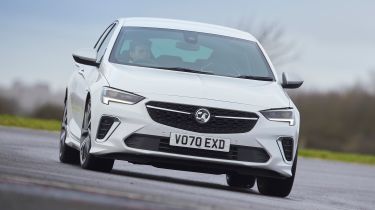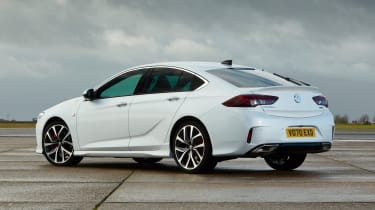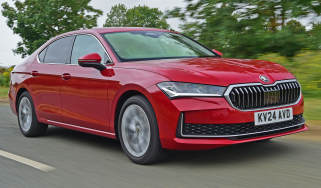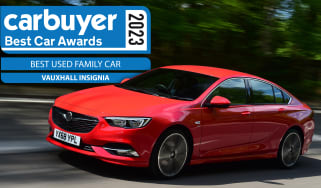Vauxhall Insignia hatchback (2017-2022) - Engines, drive & performance
An engaging backroad experience coupled with quiet motorway cruising make the Vauxhall Insignia an impressively well rounded car
While SUV sales may be escalating, such cars sit far higher off the road than the Vauxhall Insignia. That means their manufacturers must counter the body lean brought about by a higher centre of gravity, and this tends to be done by fitting stiffer suspension. This, in turn, often leads to an unforgiving experience over potholes, drain covers and other such impediments.
The Insignia doesn’t have this problem, as it’s a low car, meaning the suspension doesn’t have to cope with much body lean – although it’ll display a little if you really throw it around corners. The net result is it’s excellent at absorbing imperfections in the road and also gives the Insignia an impressive amount of grip. There’s also good feel through the steering wheel and – crucially, given the mileage Insignia owners are likely to cover – it’s an excellent motorway companion, offering a near-silent cruising experience in terms of wind, road and engine noise. The Insignia’s manual gearbox isn’t as smooth as the Ford Mondeo’s, but at least it’s satisfyingly chunky to use.
The sense of driver engagement absent from the old Insignia is most certainly present in this new car. Like the smaller Vauxhall Astra, the Insignia is enjoyable to drive without being thrilling, and rivals like the Mazda6 have a sharper feel.
More reviews
In-depth reviews
- Vauxhall Insignia hatchback review (2017-2022)
- Vauxhall Insignia Sports Tourer estate (2017-2019)
- Vauxhall Insignia Country Tourer estate (2017-2019)
- Vauxhall Insignia hatchback (2008-2017)
- Vauxhall Insignia Country Tourer (2013-2015)
- Vauxhall Insignia Sports Tourer estate (2008-2017)
- Vauxhall Insignia VXR hatchback (2009-2017)
Buyers who want a sporty Insignia should hunt out a used example of the range-topping GSi model with four-wheel drive – if you can find one. Dubbed ‘Twinster,’ the four-wheel drive system uses a pair of clutches in place of a standard differential, which enables torque vectoring that can send power to whichever wheel has the most grip. It can also be driven in front-wheel drive mode, although this makes it easy to spin the front wheels. Selecting the ‘AWD’ button on the centre console, and accelerating is both quicker and less dramatic.
The result is a car that has an agile, playful feel and the huge amount of grip on offer is especially useful in poor weather. The GSi also has a lowered sports suspension setup with three selectable driving modes. Each adjusts the steering feel of the car, with Normal and Tour modes making it feel light, which is fine for most scenarios. Dial it into Sport mode though, and the steering feels a little heavier. Regardless of which mode you select, the Insignia GSi’s steering lacks feedback and doesn’t feel particularly precise.
Vauxhall Insignia petrol engine
From January 2022, the only petrol available for the latest Insignia is a 197bhp turbocharged 2.0-litre engine. Its 0-62mph time of 7.2 seconds looks reasonable on paper but it feels a little underpowered, lacking the requisite punch of its rivals. No manual gearbox is available, with every petrol model getting a nine-speed automatic gearbox.
At the top of the Insignia range, the 227bhp 2.0-litre petrol engine was only available in the GSi trim. It has four-wheel drive as standard and uses the same nine-speed automatic gearbox, managing 0-62mph in 7.0 seconds. As before, this performance looks decent enough, but when you consider the standard petrol model without four-wheel drive can be had for much less, while delivering similar performance, it makes the GSi a niche choice.
Diesel engines
The entry-level 1.5-litre diesel engine produces 120bhp and is capable of 0-62mph in 10.7 seconds (compared to the old 108bhp engine and its time of 11.1 seconds). It’s quick enough for overtaking and has enough power for joining motorway traffic, but it's rather vocal. This engine also has a very narrow power band, so being in the wrong gear will result in sluggish acceleration when you apply the throttle.
The tall sixth gear in the manual box has been designed to reduce engine revs when cruising at high speeds – helping to reduce fuel consumption as well as lessening engine noise. It’s not a gear for acceleration, though: overtaking slower traffic often requires dropping to fifth or fourth.
Pick the entry-level diesel with the eight-speed automatic gearbox, and performance is stunted slightly, with 0-62mph taking 11.5 seconds.
If you (or your fleet manager) can stretch to it, the 172bhp 2.0-litre diesel sits almost at the top of the engine range. This is only available in GS Line trim, but doesn’t cost much more than an equivalent Insignia with the smaller diesel engine. When mated to a six-speed manual gearbox, it has an 8.2-second 0-62mph time and with its strong reserves of power it leads to effortless overtaking and is bound to appeal to those who spend a lot of time on the motorway. Go for the eight-speed automatic, and the 0-62mph dash takes a fraction longer at 8.4 seconds.















